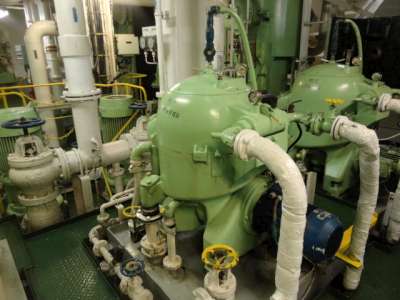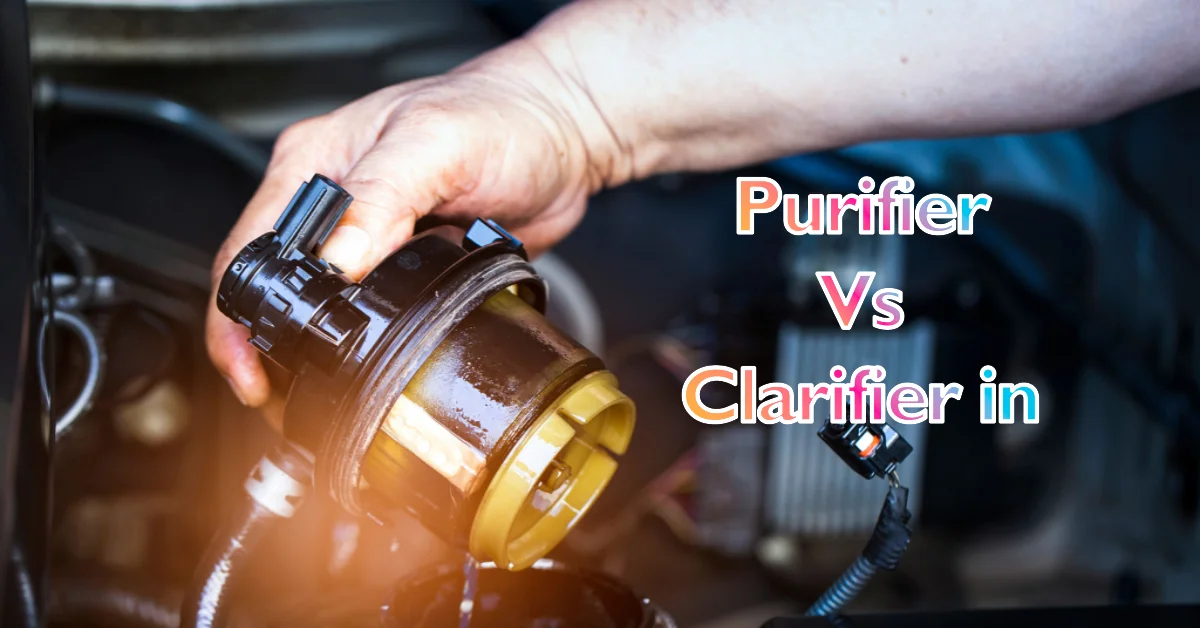Difference Between Purifier and Clarifier in Fuel Treatment

Fuel purification, a critical process in the maritime industry, relies on two centrifugal separators: purifiers and clarifiers.
Both aim to cleanse fuel and water, their methodologies, components, and outcomes exhibit notable differences.
We explore the dissimilarities between purifiers and clarifiers, highlighting their functions, key components such as dam rings and sealing rings.
Key Difference between purifier and clarifier Table
| Feature | Purifier | Clarifier |
|---|---|---|
| Purpose | Separates water, solids, and other impurities from fuel | Separates solids from fuel |
| Type of separation | Three-phase | Two-phase |
| Components | Dam ring, sealing ring, discs | Sealing ring, discs |
| Operation | Uses centrifugal force to separate the different phases | Uses centrifugal force to separate the solids from the fuel |
| Output | Clean fuel, water, and solids | Clean fuel and solids |
| Applications | Ships, power plants, industrial applications | Ships, power plants, industrial applications |
What is a Purifier?

A purifier, in the context of fuel treatment, is a type of centrifugal separator. It’s design to separate water and solid impurities from fuel. This is achieve through the use of a disc stack and a gravity disc, which help to separate the different phases based on their densities.
Purifiers find their applications in various fields. They’re commonly use in ships and boats to clean the fuel oil use for propulsion and electric energy/power. By removing water and solid impurities, purifiers help to improve the efficiency of the engines and reduce wear and tear.
What is a Clarifier?

A clarifier is design to separate only solid particles from the fuel. Unlike a purifier, a clarifier doesn’t have a gravity disc. Instead, it uses a sealing ring to prevent water and dissolved impurities from remaining inside the fuel tank.
The working process of a clarifier is similar to that of a purifier, with the main difference being the absence of a dam ring.
Clarifiers are often used as a backup system in ships and boats. If the purifier hasn’t completely removed the dissolved solid impurities from the fuel, a clarifier can be use complete clean.
Function and Components:
Purifier: Separating Fuel and Water with Precision
- The purpose of purifiers: Cleanse fuel by separating liquids of different densities (oil and water).
- Key components: Centrifugal separator, dam ring, multiple discs.
- Engineering details: Utilize centrifugal force to separate fuel and water, while removing solid impurities.
- Preventing contamination: The dam ring creates a line of separation, ensuring clean oil extraction.
Clarifier: Isolating Solid Impurities with Efficiency
- The objective of clarifiers: Separate solid impurities from fuel, along with partial removal of water.
- Essential components: Centrifugal separator, sealing ring, multiple discs.
- Enhanced performance: Increasing disc count to maximize surface area for improved separation.
- Protecting the fuel system: Sealing rings prevent water and dissolved impurities from entering the fuel tank.
Centrifugal Separators: Powerhouses Behind Purification
The vital role of centrifugal separators in both purifiers and clarifiers.
- Mechanism breakdown: Utilization of centrifugal force to drive separation.
- Guiding particle movement: Centrifugal force directs denser particles towards the periphery and lighter particles towards the center.
- Discs’ contribution: Solid impurities are channeled towards the outlet, while lighter liquid particles rise to the surface.
- Ensuring separation efficiency: Gravity discs and oil outlets play a crucial role in controlling the fuel-water interface.
Key Differences: Purifier vs. Clarifier
Separation Objective:
- Purifier: Separates fuel and water while removing solid impurities.
- Clarifier: Separates solid impurities from fuel and partially eliminates water content.
Dam Ring vs. Sealing Ring:
- Purifier: Utilizes a dam ring to create a line of separation between fuel and water.
- Clarifier: Incorporates a sealing ring to prevent water and dissolved impurities from entering the fuel tank.
Discharge and Outlet:
- Purifier: Water outlet with a greater radius for efficient removal, while solid impurities collect on the bowl walls.
- Clarifier: Removes solid impurities while allowing some water discharge through the outlet.
Tabular Comparison
| Aspects | Purifier | Clarifier |
|---|---|---|
| Function | Separates fuel and water, removes solid impurities | Separates solid impurities, removes some water content |
| Key Components | Centrifugal Separator, Dam Ring, Multiple Discs | Centrifugal Separator, Sealing Ring, Multiple Discs |
| Primary Outcome | Fuel-Water separation with some solid impurities | Fuel-Solid impurities separation with some water |
| Engineering Features | Dam ring for line of separation, efficient solid removal | Sealing ring for tank protection, efficient impurity separation |
Summary:
In conclusion, the distinction between purifiers and clarifiers lies in their objectives, components, and outcomes. Purifiers excel in separating fuel and water while effectively removing solid impurities, facilitated by dam rings.
Conversely, clarifiers focus on separating solid impurities from fuel while partially reducing water content, aided by sealing rings. Both devices leverage centrifugal force within their centrifugal separators, guiding the separation process and ensuring the purity of the fuel.
By providing a comprehensive explanation through detailed headings, subheadings, expanded content, point lists, and tables, we have shed light on the vital disparities between purifiers and clarifiers, enabling a deeper understanding of their role in fuel purification in the maritime industry.
References and Further Reading
For those interested in delving deeper into this topic, I recommend checking out the following resources:







